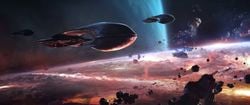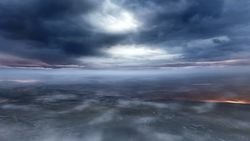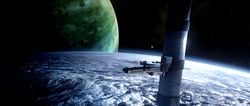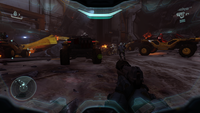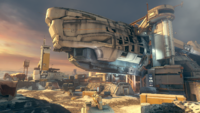Meridian
From Halopedia, the Halo wiki
| Meridian | |
|---|---|
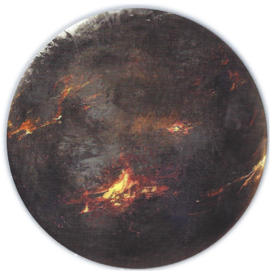
| |
| Astrographical | |
|
System: |
|
|
Orbiting: |
|
|
Orbital position: |
Seventh natural satellite[1] |
|
Moon(s): |
None[2] |
| Physical | |
|
Diameter: |
3,073 kilometers (1,909 mi)[1] |
|
Gravity: |
1.1 G[1] |
|
Atmosphere: |
|
|
Surface temperature: |
-37°C to 43°C (-34.6°F to 109.4°F)[1] |
| Societal | |
|
Species: |
|
|
Population: |
5,321[2] |
|
Colonized: |
|
|
Government: |
|
- "The Covenant glassed this planet in '48. It was a UNSC colony then, but we never came back. Run by a private corp now, chipping away the glass, making her livable."
- — Spartan Holly Tanaka[4]
Meridian, known to the Forerunners as Pridarea Libatoa,[5] is a human Outer Colony and the seventh natural satellite of the gas giant Hestia V in the Hestia system. Despite being located on the edges of human space, Meridian was a vibrant and thriving colony with a robust economy and an impressive population; mining and military production for the United Nations Space Command were known industries on the colony.[1] Once a green world, the moon held a temperate climate and fertile land.[6]
The Covenant eventually attacked the world in 2548 and, after a long battle that lasted for three years, Meridian was ultimately glassed by the Covenant in 2551. Following the Human-Covenant War, Meridian was resettled by the Liang-Dortmund Corporation. Despite being a colony of the Unified Earth Government, Meridian became an independent world following the Covenant War.[7] In 2558 a Forerunner Guardian, long-buried beneath the moon's surface, emerged in the wake of the Created uprising.[8]
History
Prehistory
- "And to think, it has been under their noses all this time."
- — A Special Operations Sangheili, after discovering the Forerunner structure beneath Meridian's surface[9]
Meridian was once within the jurisdiction of the ecumene, the Forerunner empire that stretched across the Milky Way. A number of Forerunner structures were established beneath Meridian's surface. At some point, an extensive installation was built into a cave under Meridian's surface. This structure contained a Luminary, a Forerunner device that held the coordinates to the locations of the Halo Array's installations, including Installation 00.[9] Meridian was also the location of a Guardian—a massive construct used by the Forerunners to police entire systems—buried beneath the world's surface within another cave system, which also housed numerous bodies of the Warden Eternal. Following the firing of the Halos in 97,445 BCE, the surviving Forerunners left the galaxy and the Forerunner technology on Meridian was left behind.[10]
Colonization and early history
- "Records indicate that 139 ships, carrying 70,003 souls arrived on this green ball in 2432. Since many of those settlers came from France, they named the first town Avignon, and established the colony of Meridian."
- — The History of Meridian, presented by Free Frontier Education[11]
Meridian was colonized in 2431 by humanity,[1] and settled in 2432. One hundred and thirty-nine vessels carrying 70,003 colonists—most of which came from the country of France on Earth—arrived on Meridian and established the town of Avignon.[11] Aided by colony support ships,[12] Meridian colonists initially settled equatorial coastlands, before migrating to the moon's vast supercontinent, which would serve as the center of civilization for decades on Meridian.[1] Early in the moon's history, there was a large debate over Meridian's future. While some of the world's population wished for Meridian's surface to remain untouched and largely undeveloped, others wanted to expand and build settlements across the world; the population divided themselves into two political parties known as the Stewards and the Prospector Party.[11]
The debate between the two factions ended when rich mineral deposits were found in Meridian's Mathon Mountain Range, causing a rush of new development as many worked to gain a profit from the deposits.[11] The discovery of the mineral deposits led to early success for the Prospector Party, though the Stewards gained control of Meridian after a lengthy campaign referred to as the Free Patriot Movement in 2457. After years of discord, the Colonial Administration Authority eventually recognized the Stewards.[3] Meridian also became a place of conflict during the Insurrection due to a number of antagonistic political ideologies, including the Sundered Legion of 2495.[1] However, after five years of near-constant conflict on the world, insurrectionist forces were defeated by the United Nations Space Command at the Siege of Athea.[7] Afterwards, military production became Meridian's primary source of revenue;[3] notably, Meridian was the location of dozens of Chalybs Defense Solutions' facilities, including one in the city of Angoulême.[13] Accepting contracts for the manufacturing of military equipment for the UNSC ensured economic prosperity throughout the world[3], and Meridian had became one of the most vibrant and economically diverse of Earth's Outer Colonies in the following years.[2]
Human-Covenant War
- "Almost immediately after Meridian was recaptured by the UEG, the Covenant arrived. Captain Edmund Persie of the UNSC Sevenfold Gates fought to the last, but was forced to order what few ships remained to fall back to the edge of the Hestia system. Within five hours of Captain Persie's retreat, Meridian was glassed, and all life there was eradicated."
- — The History of Meridian, presented by Free Frontier Education[7]
The Office of Naval Intelligence's Section Three had facilities on the moon, to which several SPARTAN-II augmentation chemical precursors were sent without Doctor Catherine Halsey's consent, likely in order to be researched for Project CHRYSANTHEMUM.[14]
During the Human-Covenant War, Meridian was invaded by the Covenant in 2548 and the Battle of Meridian began.[4] The Covenant, aware of Meridian's value to the UNSC, wished to cut off the world's supply lines that it provided to the rest of the UNSC. However, the UNSC resisted the attack with the aid of Meridian's impressive UNSC Air Force garrison and extensive orbital defensive grid. With conflict occurring for three years,[1] the Covenant forces were eventually repelled.[14]
However, shortly after the Unified Earth Government reclaimed the moon, the Covenant attacked the colony again in 2551.[9] During the invasion, Chalybs Defense Solutions' facilities were abandoned, with many being destroyed.[15] After a long, extended battle, UNSC Navy forces at the world were forced to retreat to the edge of the system while a Covenant fleet began glassing the moon's surface.[7] Towards the end of the battle, a small Covenant team discovered a massive Forerunner structure under Meridian's surface. In the structure, they discovered a Luminary, which they delivered to the High Prophet of Regret. The Luminary would later reveal the locations of the Halo rings, the Ark, and a slipspace portal to the Ark found on Earth.[9] While the glassing resulted in the evaporation of oceans and the loss of most life of Meridian, the atmosphere remained somewhat breathable.[16]
Recolonization efforts
- "Meridian didn't get it too bad. They hit the human settlement hard, sure, and the plasma bombardment boiled some of the oceans off, but there was enough atmosphere to hold some steam in. Covies did a rush job, and the planet survived. Less than a third is lechatelierite. So we chip away at the worst parts like cutting away the rot off an apple. Quick job. Should be done inside of twenty years."
- — William Khaleed, regarding the deglassing of Meridian[16]
Following the Covenant War's end, Meridian was recolonized by the Liang-Dortmund Corporation, though the world remained independent from the Unified Earth Government. Using the colony support ships abandoned in orbit around Hestia V during the Covenant War to facilitate their work,[12] Liang-Dortmund established a space elevator—Pinnacle Station—on the colony and hired workers to help resettle the moon and aid in the "deglassing" efforts; the settlers were comprised mainly of former Meridian residents wishing to rebuild their home or opportunists seeking profit.[11] Liang-Dortmund's intentions were to pay excavators to mine away the glass on Meridian's surface so that in a generation or two, the corporation would have land rights to an entire colony world.[10]
The smart AI, Sloan, served as Liang-Dortmund's administrator and as the colony's governor as early as December 2553[17], having been elected to the position by the people of Meridian for two four-year terms.[18] That same month, the Jiralhanae dokab of the Keepers of the One Freedom, Castor, visited Meridian. Also present was an ONI ferret team which was led by Veta Lopis and included three Spartan-III supersoldiers: Ash-G099, Mark-G313, and Olivia-G291.[19]
Settlers believed that it would take approximately twenty years to completely deglass the moon.[16] Five days into the recolonization efforts, the colonists began digging through the glass to create a road from the space elevator to a newly created settlement—Meridian Station,[11] with Apogee, Darkstar, and Jorta Stations being established shortly after.[10][20] Liang-Dortmund's efforts were occasionally impeded by Kig-Yar raiders or rival corporations seeking to conduct kinetic espionage on Liang-Dortmund's Meridian operations.[21] At some point, a group of settlers discovered the extensive Forerunner structure under Meridian's surface near Apogee Station while attempting to deglass the land above it and began working to uncover it.[16] By 2558, Governor Sloan, believing that Liang-Dortmund might provide the workers on Meridian with a bonus if they find something of value, had a group of miners attempt to force their way into the structure.[3] This installation was actually the holding bay of the world's Guardian.[18]
Rise of the Created
- "The Domain is open. Meridian is next."
- — Cortana, directing John-117 to Meridian[22]
In October of 2558, Meridian miners managed to create an entrance to the installation beneath Apogee Station. Around this time, Sloan was contacted by Cortana—a smart AI believed to have been destroyed in 2557—and offered a cure for his onset rampancy and a place within her emerging Created in exchange for his cooperation.[18] Sloan agreed, and Cortana soon contacted Spartan-II John-117 and Blue Team through the Domain and directed them to Meridian.[22] Going absent-without-leave to locate her on Meridian, Blue Team was pursued by Spartan-IV Fireteam Osiris on the orders of the UNSC Security Council.[4]
On October 27, 2558, Blue Team had arrived at Meridian and landed at Apogee Station, where they discovered the world's Forerunner structure after entering nearby mines.[10] Cortana led them deep into the structure, where the Guardian was located. Osiris followed and discovered that Meridian was under attack from Promethean forces led by the awoken Warden Eternal, Cortana's new-found ally.[4] After defeating the Warden, Osiris confronted Blue Team, though the Spartan-IIs entered the Guardian and Cortana had it rise above Meridian's surface.[10] Meanwhile, Cortana had warned Sloan of her intentions ahead of time and the governor began to evacuate Meridian's population through Pinnacle Station and Brahman light haulers. As Osiris returned to the surface, the Guardian entered slipstream space en route for her location at Genesis, destroying the space elevator in the process. With the Guardian gone, the Spartan-IVs left Meridian to determine Cortana's plans and Blue Team's location.[8] After the event, the UNSC had apparently secured the world.[23]
Once the dust had settled, survivors at Meridian Station banded together to keep one another alive and to try to get word off-world. Evelyn Collins, Doc Cale, Marquez, and Phan were able to reach out to Cortana to ask for help after the A.I. had broadacast an offer of alliance with an ultimatum to the galaxy. Cortana shortly responded to the four of them and stated that all would be dealt with in time.[24]
While the Guardian's activation heavily damaged Liang-Dortmund's local headquarters at Meridian Station and resulted in the destruction of Pinnacle Station, the corporation's regional directors implemented contingency plans to mitigate the economic impact and reconstitute operations on Meridian. Relocating to the surviving Darkstar Station on the other side of the world with many of the corporation's employees now stationed in Meridian's orbit, Liang-Dortmund continued to work to extract Meridian's resources, despite the uncertain astro-political climate that resulted from Cortana's efforts. However, several Forerunner artifacts within Meridian's mantle were since reactivated, drawing the attention of the UNSC.[20]
Topography
- "The so-called glass is a mineral called lechatelierite. It is a result of the Covenant lances striking the surface of the planet with plasma, converting the topsoil to glass. Any attempt to make a glassed planet habitable would mean cutting the surface down to below the topsoil."
- — An observer commenting on Meridian's surface[7]
A small world with a diameter of 3,073 kilometers (1,909 miles), Meridian was once a green world with impressive, Earth-like features, which made the moon a prime target for human colonization. The world is home to a vast supercontinent, with verdant equatorial coastlands.[1] Residents enjoyed the world's temperate climate and fertile soil. Meridian was home to rich mineral deposits[6]—particularly in the Mathon Mountain Range[11]—that helped fuel the moon's economy.[7]
However, after the Covenant glassed the world in 2551, Meridian's topsoil had been reduced to molten slag and soil covered by lechatelierite.[1][7] Meridian's surface became a treacherous and inhospitable environment,[25] with scattered bodies of molten, liquid "glass".[26] However, the Covenant's glassing of Meridian had been been rushed and only a third of the world's surface had been coated in lechatelierite; though the moon's oceans had evaporated due to the heat of the plasma bombardment, the world's oxygen-nitrogen atmosphere remained relatively intact. Some lifeforms, such as small plants and arthropods, still thrived in caverns on the world.[16] However, Meridian was now subject to extreme conditions and temperatures,[3] with the surface temperature varying from -37°C to 43°C (-34.6°F to 109.4°F).[1] Settlements on Meridian were forced to be outfitted with air filters, as much of the world's air was filled with tiny glass particles that proved dangerous to human lungs if enough were inhaled.[3]
A high concentration of Forerunner artifacts exists on Meridian; their presence is known to the Office of Naval Intelligence.[27] Beneath Meridian's surface, there were at least two vast Forerunner structures built into natural cave formations, though both structures were possibly connected. One structure contained a Luminary that had the location of the Halo Array, which was collected by the Covenant during their attack on the world in 2551.[9] The second one was home to a Forerunner Guardian, as well as numerous host bodies of the Warden Eternal.[10]
Government and politics
- "Despite the early success of the Prospector Party, the Stewards gained control of Meridian after a lengthy campaign known as the Free Patriot Movement. The Colonial Administration Authority eventually recognized the Stewards, ending years of strife."
- — The History of Meridian, presented by Free Frontier Education[3]
Meridian was an Outer Colony under the administration of the Unified Earth Government and its Colonial Administration Authority. Due to Meridian's importance to the UEG, the world had a strong United Nations Space Command presence, with a large UNSC Air Force garrison and an extensive orbital defense grid.[1] The UNSC Navy's Office of Naval Intelligence also had several facilities on the world.[14] Towards the end of the Battle of Meridian, naval forces at Meridian were led by Captain Edmund Persie of UNSC Sevenfold Gates.[7] Early in Meridian's history, two political parties—the Stewards and the Prospector Party—debated over whether Meridian's surface should be left largely untouched or developed, respectively. Though the Prospector Party saw initial political success after the discovery of rich mineral deposits on Meridian,[11] the Stewards eventually gained control of the world after their lengthy Free Patriot Movement campaign in 2457.[1] The Stewards were later officially recognized by the Colonial Administration Authority.[3] Despite the UNSC's strong presence on the moon, the Insurrection had some level of prominence on Meridian prior to the Human-Covenant War. Insurrectionist factions, such as the Sundered Legion, spread antagonistic political ideologies throughout Meridian in an effort to create strife against the Unified Earth Government, though they ultimately proved ineffective.[1]
After Meridian's glassing during the Battle of Meridian in 2551, the UNSC did not return to the world for the rest of the Covenant War. Meridian was eventually reclaimed by the Liang-Dortmund Corporation, which sought to resettle the world and make the moon habitable again.[4] However, the UNSC believed the corporation was intent on claiming the entire world for itself once it was recolonized.[10] Despite Meridian's former loyalties to the UEG and UNSC, the world had become an independent colony that was now beyond the jurisdiction of the UEG.[4] Overseen by a board of regional directors,[20] the colony's Liang-Dortmund administrator and colonial leader was Sloan, a smart AI with insurrectionist sympathies that was suffering from the onset of rampancy as of 2558.[28] Sloan was democratically elected as governor of the colony by the citizens of Meridian Station for two consecutive four-year terms.[18] The corporation also provides Meridian with private security and is outfitted with a variety of UNSC military-grade equipment,[4] acquired through seemingly illegal methods from a dealer known as "Bozo".[11] Jorta Station serves as the command center for Liang-Dortmund's private security forces, housing numerous pieces of equipment meant to ward off threats to the corporation's operations on Meridian.[21]
Economy
- "Military production served as the colony's primary source of revenue, and the contract for the Scorpion MBT ensured Meridian's bright future."
- — The History of Meridian, presented by Free Frontier Education[3]
Relatively unusual for an Outer Colony on the edge of human space, Meridian was once home to a powerful and robust economy, that was initially fueled by many outsiders attracted by the world's rich culture and Earth-like features. Prior to the world's fall in 2551, Meridian was one of the most vibrant and fastest-growing colonies throughout all of human space.[1] Military production for the Unified Earth Government and its United Nations Space Command served as the colony's primary source of revenue.[3] Several military contractors took residence on Meridian; most notably, Chalybs Defense Solutions in 2479.[1] CDS's contract for M808 Scorpion production ensured economic success across Meridian.[3] CDS had several facilities across Meridian's surface, including in the city of Angoulême,[13] though all facilities were either abandoned or destroyed by 2551.[15] Meridian also had a powerful mining industry that began after rich mineral deposits were found in the Mathon Mountain Range, shortly after the world's colonization.[11] During the Human-Covenant War, supply lines originating from Meridian provided the UNSC with equipment at other fronts in the war.[1]
After Meridian's recolonization, a relatively small group of Liang-Dortmund Corporation contractors and resettlers attempted to rebuild the world's once prosperous economy. The corporation based their operations at the base of Meridian's sole remaining space elevator, Pinnacle Station, and established makeshift settlements such as Meridian Station. Liang-Dortmund has since established several mining platforms throughout Meridian, scouring for remaining rare metal and mineral deposits across the world's surface.[1] By 2558, Meridian was regarded as a backwater world on the frontier.[22]
Culture and society
- "Grew up on an indie colony like Meridian. Folks out here don't take kindly to the UNSC landing in the middle of town. Tend to see it as an act of aggression."
- — Spartan Holly Tanaka, commenting on Meridian's relationship with the UNSC in 2558[4]
Meridian once boasted a rich culture that, along with its natural makeup, attracted many outsiders, fueling cultural diversity across the world. Meridian was considered to be one of the most vibrant and quickly growing colonies across all of human space, prior to the Human-Covenant War.[1] The Old Refrain was a musical composition familiar to colonists of the moon and remained so for many years.[24] Following Meridian's glassing in 2551 and recolonization, Meridian was resettled by former residents and opportunistic excavators paid by the Liang-Dortmund Corporation.[11] Some settlers believed that future generations raised on Meridian's treacherous surface would by physically and mentally tougher than those raised on other worlds.[16] Now independent from the Unified Earth Government, Meridian's new settlers held low opinions of the UEG and its United Nations Space Command, regarding the government with antipathy and viewing a UNSC presence as an act of aggression.[4] Many Meridian settlers regarded Spartans as "thugs" and were distrustful of them; their opinions fueled by Governor Sloan,[28] who held insurrectionist sympathies.[18]
Behind the scenes
- "The Meridian style in general is similar to the UNSC but even more industrial. In this environment, things don't need to be decorative or polished, just functional."
- — Justin Oaksford, on the design of Meridian for Halo 5: Guardians[29]

|
Browse more images in this article's gallery page. |
First mentioned in ancillary material for Halo: Reach, Meridian was first depicted in Halo 2: Anniversary's terminals. Meridian was subsequently featured as a major location for the second arc in Halo 5: Guardians. For the game, architecture on Meridian was designed to be of a similar style to that of the United Nations Space Command, though more industrial in nature. While UNSC buildings often appear polished and decorative, structures on Meridian only needed to appear functional, reflecting on the hardscrabble life on the world.[30] Environments and settlements on Meridian were designed to appear "lived-in". Meridian's glassed landscape was designed to appear nature in flowing shapes melted in place, to contrast with the man-made architecture. The majority of the world's background geology were custom sculpts to achieve the visual. Molten, liquid glass was added to the environment to add color and hue to the scene. Props throughout the levels on Meridian were colored with a warm hue to make them contrast with the gray background of Meridian's glassed surface.[26]
Despite being consistently depicted as a moon of Hestia V in all of its visual appearances, Meridian is often mistakenly referred to as a planet throughout Halo 5: Guardians as well as other sources. Strangely, Meridian is referred to as a "planet-moon" in a Canon Fodder that expanded on the lore behind the Halo 5: Guardians multiplayer map "Skirmish at Darkstar".[20]
Gallery
- H5-ConceptArt-Mining.jpg
Concept art.
- H5-ConceptArt-OsirisForerunnerPlatforms.jpg
Concept art of the Guardian under Meridian.
Castor and Veta Lopis on Meridian's glassed surface.
List of appearances
|
|
Sources
- ^ a b c d e f g h i j k l m n o p q r s t u v w x y Halo Waypoint: Meridian
- ^ a b c Halo: Warfleet, p. 23
- ^ a b c d e f g h i j k l Halo 5: Guardians, campaign level, Unconfirmed - Mission Intel
- ^ a b c d e f g h i j Halo 5: Guardians, campaign level, Glassed
- ^ Halo: Retribution, chapter 16
- ^ a b Halo Waypoint: Canon Fodder - Know for an Answer
- ^ a b c d e f g h Halo 5: Guardians, campaign level, Evacuation - Mission Intel
- ^ a b Halo 5: Guardians, campaign level, Evacuation
- ^ a b c d e Halo 2: Anniversary, Terminal 14
- ^ a b c d e f g Halo 5: Guardians, campaign level, Unconfirmed
- ^ a b c d e f g h i j k Halo 5: Guardians, campaign level, Glassed - Mission Intel
- ^ a b Halo Waypoint: Meridian 5-Alpha
- ^ a b Halo Encyclopedia, page 97 (2011)
- ^ a b c Halo: Reach, Dr. Halsey's personal journal
- ^ a b Halo 4: The Essential Visual Guide, page 172
- ^ a b c d e f Halo 5: Guardians, campaign level, Meridian Station - Mission Intel
- ^ a b c d e Halo Waypoint: Governor Sloan
- ^ Halo: Retribution
- ^ a b c d Halo Waypoint: Canon Fodder - Glassed Ceiling
- ^ a b Halo Waypoint: Canon Fodder - Buzz Generating
- ^ a b c Halo 5: Guardians, campaign level, Blue Team
- ^ Hunt the Truth Season 2, Episode 1: CUBE B-349
- ^ a b Halo: Fractures, What Remains
- ^ Halo Waypoint: Canon Fodder - Looking Glassed
- ^ a b Halo Waypoint: Halo 5 Art Showcase
- ^ Data Drop, 93893-PRELIM
- ^ a b Halo 5: Guardians, campaign level, Meridian Station
- ^ The Art of Halo 5: Guardians, page 58
- ^ The Art of Halo 5: Guardians, pages 58-72
